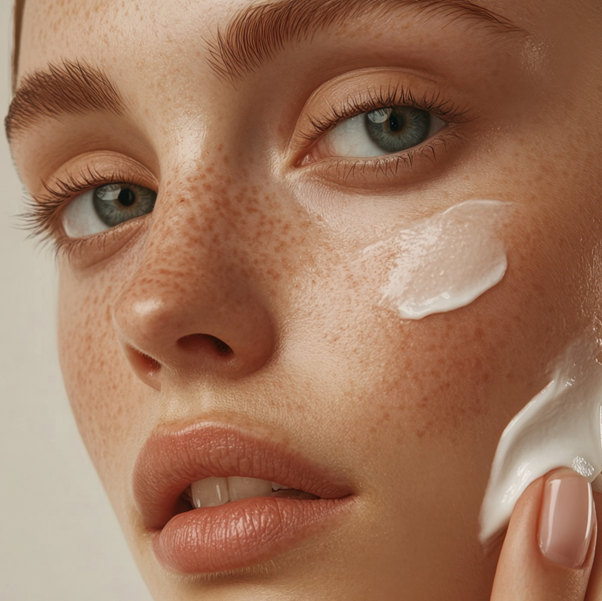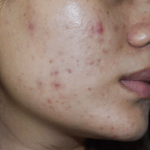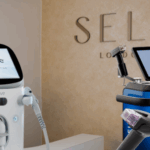
The conversation around menopause and skin has never been louder. Oestrogen decline in midlife influences collagen, hydration and elasticity, and the idea of putting the hormone back into the skin is understandably appealing. At the same time, social media has fuelled a trend of applying prescription vaginal oestrogen to the face for lines and dryness.
As a dermatologist-led clinic on Harley Street, Self London focuses on what is true rather than what is trending. A recent systematic review, published in the Journal of the American Academy of Dermatology in 2025, gathered all available clinical trials of topical oestrogen and analysed what the science really shows. This blog translates those findings for patients and sets them in a wider pathway that addresses both skin and midlife health.
What the new review examined
The review collected clinical trials of several oestrogen preparations applied directly to skin:
- Oestradiol (E2): the most studied, across small trials, with only one rigorous randomised controlled trial.
- Oestriol (E3): one randomised controlled trial and two open-label studies.
- Conjugated equine oestrogens and oestrone: studied in single small trials.
- Methyl-oestradiol-propanoate (MEP): three pilot studies, one with a vehicle control.
- Phytoestrogens: three randomised controlled trials.
Most studies were small, short (typically 6 months or less), and heterogeneous in design. Doses, formulations, and safety assessments varied widely, limiting strong conclusions.
Where trials suggested benefit
- Oestradiol and oestriol: most consistent findings were increases in dermal thickness and collagen, sometimes linked with firmer, better-hydrated skin.
- Conjugated equine oestrogens: one trial showed improved skin thickness and reduced fine wrinkles.
- MEP: early pilot studies suggested improvements in markers of ageing, with serum testing in one study showing only non-oestrogenic metabolites.
- Phytoestrogens: increased skin thickness and hyaluronic acid in small trials, though consistently weaker than estradiol.
Two design details matter:
- Ultraviolet-exposed skin (such as the face) often responds less well than protected areas.
- No trial directly compared topical oestrogen with retinoids. One study even found oestradiol slightly less effective than glycolic acid.
Where results were weaker or concerning
- Oestrone: one trial showed no benefit on wrinkles or elasticity and increased collagen-degrading enzymes in sun-exposed skin.
- Pigment change: hyperpigmentation was reported occasionally with oestradiol and oestriol. Given oestrogen’s link with melasma, this risk cannot be ignored.
Safety signals and unanswered questions
Some trials reported systemic effects:
- Breast tenderness or pain with oestradiol, oestriol, and conjugated equine oestrogens
- Raised prolactin in one oestradiol study
- Shifts in vaginal cytology with conjugated equine oestrogen
Critically, no study assessed endometrial safety when facial and vaginal oestrogens were combined. For women with a uterus, unopposed oestrogen raises the risk of endometrial hyperplasia unless paired with a progestogen. This gap is why casual use outside medical supervision is not safe.
The biological rationale
Oestrogen receptors exist in keratinocytes and dermal fibroblasts. Oestrogen signalling influences collagen synthesis, glycosaminoglycans and vascularity. Its decline after menopause corresponds with reduced collagen and thinner skin.
The challenge is that photoaged facial skin has altered collagen, chronic inflammation, and increased pigment activity. This may explain why topical oestrogens sometimes show structural improvements (like thickness) but not consistent visible wrinkle reduction.
What the review did not show
- That topical oestrogens are superior to retinoids or glycolic acid
- That combining face and vaginal application is safe
- That dosing protocols or long-term safety are established
- That these products can be used casually without supervision
Where topical oestrogen might sit in a modern plan
The evidence suggests that oestrogens can influence skin structure, but gaps in safety and consistency mean they should not be first-line. A responsible plan prioritises:
- Photoprotection every day
- Retinoids as the most effective topical for photoageing
- Devices such as Sofwave, UltraClear, BBL and HALO to improve firmness, pigment, and elasticity with clear evidence
- Lifestyle factors, including nutrition, movement and sleep
How Self London applies this evidence
At our medical dermatology clinic on Harley Street, we integrate skin, hormones, and women’s health:
- VISIA-led consultations measure texture and pigment, and track changes over time using our VISIA skin analysis machine
- Women’s health reviews to assess hormone therapy, vaginal oestrogen use, uterus status and cancer screening before any oestrogen decision
- Evidence-based skincare with retinoids, pigment-safe brighteners, and barrier support as the foundation
- Devices to rebuild collagen and improve elasticity with stronger evidence and safety profiles
- Pelvic health and muscle support (EmFemme, Pure Impact EMS) to strengthen core and glutes, which influence posture, confidence, and visible ageing
Practical guidance for patients
If you are considering topical oestrogen for your face:
- Be aware that evidence is limited and trials were short.
- Do not self-apply vaginal oestrogen creams to the face.
- Always disclose hormone therapy, vaginal oestrogen, and uterus status to your clinician.
- Consider pigment risk if prone to melasma.
- Seek medical supervision and agree a defined, monitored trial period.
Frequently asked questions about topical oestrogen and skin
Does oestrogen cream work for wrinkles?
Small studies suggest modest improvements in thickness, firmness and hydration, but not superiority over retinoids.
Is it safe to put vaginal oestrogen on my face?
No, it is not safe to put vaginal oestrogen on your face. There is no evidence on combined safety with vaginal use, and systemic effects were seen even with facial use.
Do plant-based oestrogens work?
They can improve collagen and hydration modestly, but the effects are weaker than oestradiol.
What about MEP (Methyl-oestradiol-propanoate)?
Early pilot data are promising, but studies are small and not yet definitive.
Will oestrogen creams worsen melasma?
Hyperpigmentation was infrequently reported, but oestrogen is associated with melasma. Caution is advised.
Book your consultation at Self London
At Self London we do not chase trends. We offer clear, evidence-based pathways for skin and midlife health. If you are curious about the role of hormones in your skin, we will assess your baseline, review your wider health, and integrate proven treatments with emerging options safely.
Book your consultation at our clinic on Harley Street today and let us help you navigate skin and hormone health with clarity and confidence.





